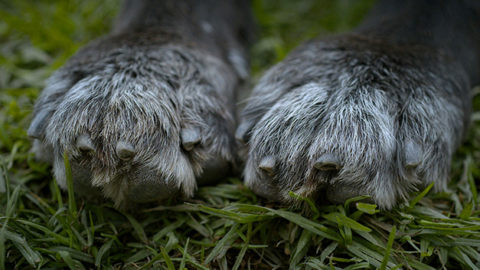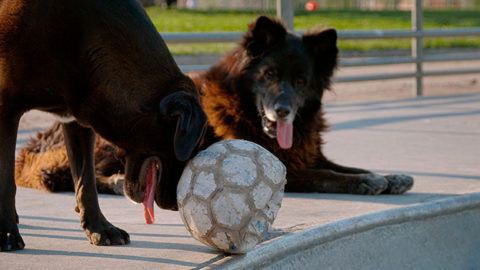Los Reyes: Bettina Perut and Iván Osnovikoff
Los Reyes screens Saturday, February 9 at Film Society of Lincoln Center as part of Film Comment Selects.
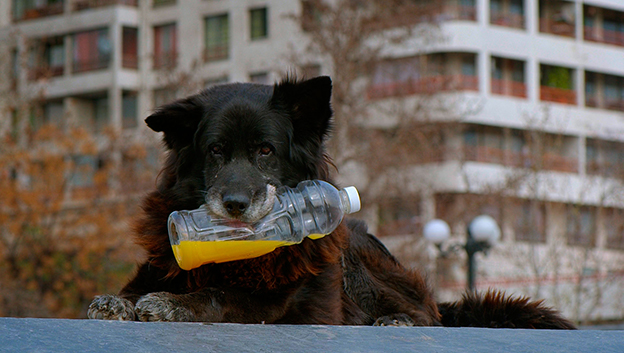
When Bettina Perut and Iván Osnovikoff set out to make Los Reyes, it was never meant to be a film about dogs. The plan was to follow the lives of the teenage skaters who populate the skate park at Parque de Los Reyes, the oldest public skate park in Chile. Over time, these teens shifted to the periphery, removed from the visual field but kept on as off-screen commentators, with their stoned musings slowly terraforming Santiago’s sociopolitical landscape. Corrupt cops, a rough job market, drug addiction—the scene isn’t particularly hopeful. There’s a sense that youth is fleeting, and that it may soon be time to put away such childish things and give in to growing up. The counterpoint to all this comes in the form of two friends: Fútbol, a beautifully mangy mutt with thick black hair, a tawny under-mane, and mottled gray paws; and Chola, a dark chocolate lab who likes to play with balls and bark at intruders (her politics lean towards anarchism—police and government workers are spurned, skaters left alone). The pair is forever young, living loose and lazy and lounging in the sun.
Los Reyes opens with a shot of Santiago’s skyline, revealing its many layers as they cascade down towards the park: white-capped mountains in the distance, then skyscrapers, trees, some scattered buildings, a highway, and then finally, the park and its inhabitants. Demarcating space is central to the film, and to this end Fútbol and Chola function as canine cartographers. Moseying about the park and marking their territory, the dogs highlight all the best places to wash off, grab a drink, or soak in the night life. And then the filmmakers look deeper, reframing the space with intense close-ups, studying the physiognomy of a dog dream, the textures of a paw, the papillae of a tongue. Details are abstracted and made alien; biology is broken down. This continues until the figure of the “dog” dissipates entirely, and we are reminded, after spending so much time alongside these animals, just how unknowable they are.
Los Reyes screens Saturday, February 9 at the Film Society of Lincoln Center as part of Film Comment Selects. For the occasion, we present with permission an abridged transcript of the following interview with Perut and Osnovikoff by Eric Hynes, Curator of Film at Museum of Moving Image, at the International Documentary Film Festival Amsterdam.
This film has a story behind the story that I’d love if you could share—in the sense that, this isn’t quite the film that you thought you were making.
Bettina Perut: Obviously, when you watch the film so many times, you become a little detached from it. But even then, there’s always a feeling of pain because we were very attached to Fútbol and were present when he died. When that happened, we were already editing. We were at the end of the editing process. As Fútbol continued living in the first raw cut, he was resurrected. But after that, we made the decision of having him die in the story of the film. Not to match reality with the film, but because it was better for the film to finish that way.
When we stopped shooting the film and began editing, for a long, long year we went to see Fútbol and Chola three times a week. We gave them tennis balls and stayed with them—one hour, two hours—and we really loved them. And we were in contact with Esmeralda, an old woman who lives in the apartment at front of the park, and she knew Fútbol some years ago when he first arrived. He was in very bad condition, and Esmeralda began to feed him and care for him and slowly he recovered. Some time later, Esmeralda met Chola near the lagoon you see in the film, and she began to feed her, too. She would go to the park and play with the balls, and Fútbol saw Chola then, and the two became like an existential pair. In the skate park, there were two football fields nearby.
Iván Osnovikoff: He began to chase after the football players. So, Esmeralda called him “Fútbol.” That’s the origin of the name.
BP: We were in contact with Esmeralda [throughout] that year, and one day she called us saying that Fútbol was acting very strange—was always, for hours, laying in the same place. And I said to Esmeralda, “Esmeralda, maybe Fútbol just wants to stay there?” But hours later, she called us saying that she was with Fútbol and that he was [doing poorly]. And we ran. We went immediately to take Fútbol to the hospital, and we stayed with him. The exams said that he [had ingested] poison. We stayed with him for two days, trying to do something for him, and he died with us, with Iván, Esmeralda, and me. We really have special feelings for Fútbol because I think he’s an example of…
IO: Continuing to fight in life.
BP: I’m very touched by Fútbol’s death, and so today I cry for him.
The relationship between the documentary filmmaker and the subject is a complicated one, and an intense one, in that you get incredibly close and you observe lots of life and you become essential to each other for the duration of making it, and then it’s difficult to know, once it’s over, what the relationship should be. I’d love to know how your previous experiences relate to this.
IO: I would say that in general we need to be very close to characters and the space because, when shooting a film, through the whole process, it’s a necessary thing. If you are not very close it’s difficult to get the confidence that you need to shoot a film. But it’s incredible that this is the first time that we, after ending shooting, continued to have a relationship with our characters. In the previous film [Surire (2015)], it was [much simpler] because it was shot in the highlands in the north of Chile, in a very isolated place, very difficult to communicate with, so it was not natural.
BP: I would also like to say that we adopted Chola. It was a very difficult decision because, above all, she was a free dog. There are few dogs that are happy and free. But two months ago she disappeared for a whole day and night, and we began, with a lot of people, to look for her, and [found] nothing. And then one morning, two days later, I went to park and I began to scream: “Chola! Chola! Chola!” And she jumped into my back! And it was crazy because I saw her but I was confused—I didn’t know if she was Chola. So, after that, we [made] the difficult decision to adopt her.
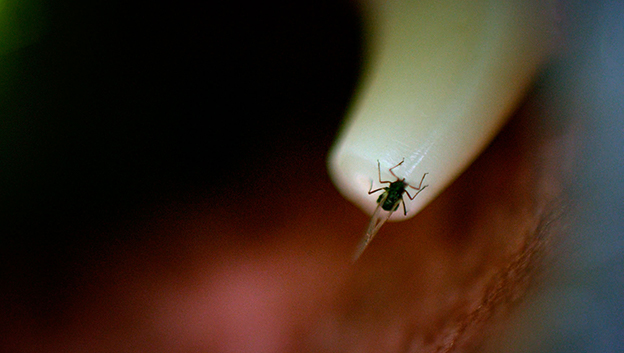
I’m fascinated by how close you were to the dogs, and I imagine it would have been difficult to have them not somehow engage with you. How did you navigate being able to shoot them in the environment without having them break character, in a sense?
IO: It’s true. A month ago, I went with a group of students for a [learning] exercise at the beach. And they began to, naturally, record dogs. And the dogs were following them. It wasn’t the same. After two days I think the dogs would say, OK, these guys are boring. But for us it was very useful that [the park] was their territory. They were not passing by once a day, they stayed there. Chola didn’t like to cross the street, so they were mainly there. They were also very interested in our balls! [Laughs] So they were very happy when we arrived in the morning. Once they had the balls they didn’t [pay us much attention]. They would lay there, play a little bit, have some food, sleep a lot, and we followed them. We knew they wouldn’t go too far, and we knew, more or less, what their dynamics were, but, always, all the sequences are constructed randomly. The years that we’ve been working together have taught us to have a methodology to capture randomness in an aesthetic way.
What’s that methodology then?
BP: We are just three persons: Iván, Pablo [Valdés], the cinematographer, and me. We’ve been working together for 15 years. When Pablo [first came] to us, he worked at a television station, and so, since the beginning, he told us, “Remember me. I’m making a documentary—another kind of documentary—not TV, okay?” So we began to discover new points of view from which to see reality, to make cinema. We wanted to avoid the presence of human beings, and verbal language, and this made the image more important because, always, the image speaks for itself more strongly than language.
Because of our experience, we know how to work together, to [make quick decisions] about where to put the camera, because life is always completely random, and if you’re not prepared to capture that randomness, nothing important happens—you lose that. And always, with dogs in the park, [unexpected things happen], and you must be prepared.
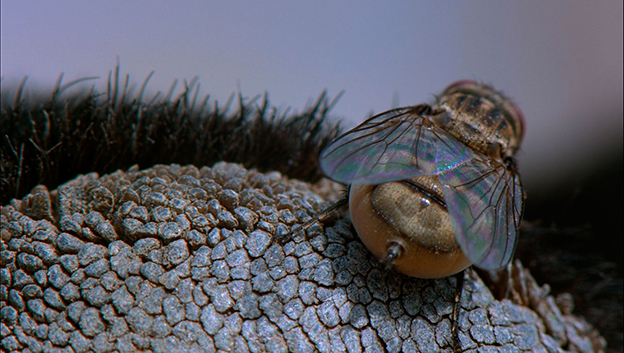
On some days it seems that maybe you’re on a surveillance level, you’re way up, and then other moments you have close-ups of flies on their body. That’s an incredible distance to be able to span.
IO: That’s always, in some way, part of our methodology, but also our conception of how to construct an image of a film. It has to do also with the centrality that human beings have with not only filmmaking, but writing, et cetera. So we think it’s very important. There are lots of contemporary philosophers that are working on that idea—that we need to [move away] from the center, not because human beings are not important, but because, to look at oneself all day, that can be bad, if you take it at an individual level. For us it’s very important in this film to state that strongly. And also, it has to do with the wideness, or the variety, or the dynamics of the image. So, I think, for three or four films, we’re working very hard on opening the image and working with the whole range of dynamics you can have.
You basically shot a different film before this film, correct? The original focus was very different.
BP: Human.
It was human. Can you tell us a little what that was about?
BP: Documentary films always change in the process of shooting. We think that that process is really the research, and most of the time you have a whole other idea, just a sensation, but when you begin to shoot you discover your documentary there. But we began because, Iván went there to skate, and he discovered some interesting things, some interesting characters, and we began, like a lot of documentaries, to apply for funding. And it was more or less interesting to talk about teenagers, their stories, their problems. Then the time came to pass, and we had to begin shooting the characters, the park, the people, the skaters, and I was very…
IO: One day I was skating, Bettina called me and said, “This film is a failure!”
BP: No! Because it was not a film of ours. It didn’t have our artistic seal. I [very much disliked] the presence of human beings, in this movie more than others.
IO: I was sitting on the border of the bowl, the big bowl, listening to this. And it was impossible, because we had already spent the money, and I thought that we needed to go forward. I saw Fútbol and Chola playing and I told Bettina, “You need to see this.” And she saw the dogs, and she said, “This film has to be about these two dogs.”
BP: If they hadn’t been special dogs, I’m sure we would’ve found another element. It’s not like they were just dogs. When I saw them, I saw the game of the ball, I saw their eyes, their gaze, their pull—it was a whole world of aesthetic possibility that we could go into. For me, just through the dogs, we had found our [artistic] seal.
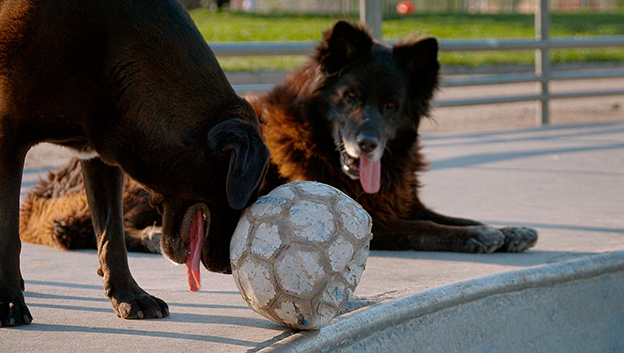
And the audio of the skaters that we hear, was that recorded previously or was that recorded alongside the dogs?
IO: During. We found that in front of the camera the skaters changed. Without the camera, they would talk about anything, they became very outgoing, but when filming became a little shy. By the way, when they figured out that we were not shooting them anymore, but were shooting the dogs, they were surprised at first, but then they relaxed. Knowing that they weren’t the protagonists of the film allowed them to have more conversations.
BP: It was difficult for the characters in the beginning to let go, but I knew that, with time, it was possible. It would have been a narrative film, but it wasn’t our film.
Just the element of the skaters being there is powerful to me. What we do overhear is interesting, and their relationship to that space, it’s sort of a very narrow frame where everything is outside of the frame.
BP: It’s another space. There’s the space of the park, the surrounding of the park, the space in some specific part of the park, the space of the bodies of the dogs, the little insects. But you are right, there’s also an imaginary space. When you hear the skaters that talk, there’s another space, somewhere. There’s also another space that’s very difficult for human beings [to see], it’s [only possible] with the camera. It’s the space of the paws, the feet of the dogs, for example, the flies.
IO: With different lenses you open the space. It was incredible for us, but, in filming, we were discovering many things in space.



